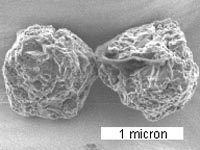Murchison meteorite
| Murchison meteorite | ||
|---|---|---|
Observed fall Yes | | |
| Fall date | 28 September 1969 | |
| TKW | 100 kg (220 lb) | |
 Pair of grains from the Murchison meteorite | ||
The Murchison meteorite is a meteorite that fell in Australia in 1969 near Murchison, Victoria. It belongs to the carbonaceous chondrite class, a group of meteorites rich in organic compounds. Due to its mass (over 100 kg or 220 lb) and the fact that it was an observed fall, the Murchison meteorite is one of the most studied of all meteorites.[2]
In January 2020,
History
On 28 September 1969 at approximately 10:58 a.m. local time, near Murchison, Victoria, in Australia, a bright fireball was observed to separate into three fragments before disappearing,[1] leaving a cloud of smoke. About 30 seconds later, a tremor was heard. Many fragments were found scattered over an area larger than 13 square kilometres (5.0 sq mi), with individual mass up to 7 kilograms (15 lb); one, weighing 680 grams (1.5 lb), broke through a roof and fell in hay.[1] The total collected mass of the meteorite exceeds 100 kilograms (220 lb).[4]
Classification and composition
The meteorite belongs to the
In January 2020, astronomers reported that Murchison meteorite
Organic compounds

Murchison contains common amino acids such as glycine, alanine, and glutamic acid as well as unusual ones such as isovaline and pseudoleucine.[9] A complex mixture of alkanes was isolated as well, similar to that found in the Miller–Urey experiment. Serine and threonine, usually considered to be earthly contaminants, were conspicuously absent in the samples. A specific family of amino acids called diamino acids was identified in the Murchison meteorite as well.[10]
The initial report stated that the amino acids were
| Compound class[17] | Concentration ( ppm )
|
|---|---|
| Amino acids | 17–60 |
| Aliphatic hydrocarbons | >35 |
| Aromatic hydrocarbons | 3319 |
| Fullerenes | >100 |
| Carboxylic acids | >300 |
| Hydrocarboxylic acids | 15 |
| Purines and pyrimidines | 1.3 |
| Alcohols | 11 |
| Sulfonic acids | 68 |
| Phosphonic acids | 2 |
| Total | >3911.3 |
The meteorite contained a mixture of left-handed and right-handed amino acids; most amino acids used by living organisms are left-handed in
Several lines of evidence indicate that the interior portions of well-preserved fragments from Murchison are pristine. A 2010 study using high resolution analytical tools including spectroscopy, identified 14,000 molecular compounds, including 70 amino acids, in a sample of the meteorite.[19][20] The limited scope of the analysis by mass spectrometry provides for a potential 50,000 or more unique molecular compositions, with the team estimating the possibility of millions of distinct organic compounds in the meteorite.[21]
Nucleobases
Measured
See also
Notes
- ^ That makes the stardust grains in the Murchison meteorite presolar grains, since they originated at a time before the Sun was formed.
References
- ^ a b c Meteoritical Bulletin Database: Murchison
- S2CID 93938395.
- ^ PMID 31932423.
- ^ Pepper, F. When a space visitor came to country Victoria Archived 1 October 2019 at the Wayback Machine ABC News, 2 October 2019. Retrieved 2 October 2019.
- .
- ^ "Planetary Science Research Discoveries: Glossary". Archived from the original on 24 January 2012. Retrieved 24 January 2012.
- PMID 16591973.
- ^ Weisberger, Mindy (13 January 2020). "7 Billion-Year-Old Stardust Is Oldest Material Found on Earth - Some of these ancient grains are billions of years older than our sun". Live Science. Archived from the original on 14 January 2020. Retrieved 13 January 2020.
- S2CID 4147981.
- PMID 15194825.
- S2CID 4341990.
- S2CID 4338550.
- S2CID 10979716.
- S2CID 4411982.
- S2CID 4424928.
- from the original on 16 January 2020. Retrieved 2 July 2019.
- ^ Machalek, Pavel (17 February 2007). "Organic Molecules in Comets and Meteorites and Life on Earth" (PDF). Department of Physics and Astronomy. Johns Hopkins University. Archived from the original (PDF) on 17 December 2008. Retrieved 7 October 2008.
- PMID 15834501.
- ^ Walton, Doreen (15 February 2010). "Space rock contains organic molecular feast". BBC News. Archived from the original on 16 February 2010. Retrieved 15 February 2010.
- from the original on 2 December 2012. Retrieved 16 February 2010.
- ^ Matson, John (15 February 2010). "Meteorite That Fell in 1969 Still Revealing Secrets of the Early Solar System". Scientific American. Archived from the original on 19 March 2011. Retrieved 15 February 2010.
- S2CID 14309508. Archived from the original(PDF) on 10 August 2011. Retrieved 7 October 2008.
- ^ "Australian meteorite one of three with key building blocks for life's 'prebiotic soup'". ABC News. 27 April 2022. Retrieved 27 April 2022.
External links
- Rosenthal, Anne M. (12 February 2003). "Murchison's Amino Acids: Tainted Evidence?". Astrobiology Magazine. Archived from the original on 30 August 2004.
{{cite web}}: CS1 maint: unfit URL (link) - Matson, John (15 February 2010). "Meteorite That Fell in 1969 Still Revealing Secrets of the Early Solar System". Scientific American.
![]() This article incorporates public domain material from websites or documents of the
This article incorporates public domain material from websites or documents of the
